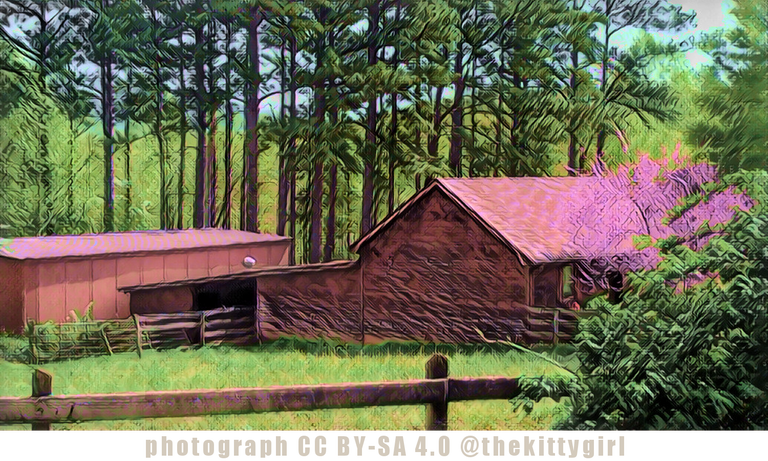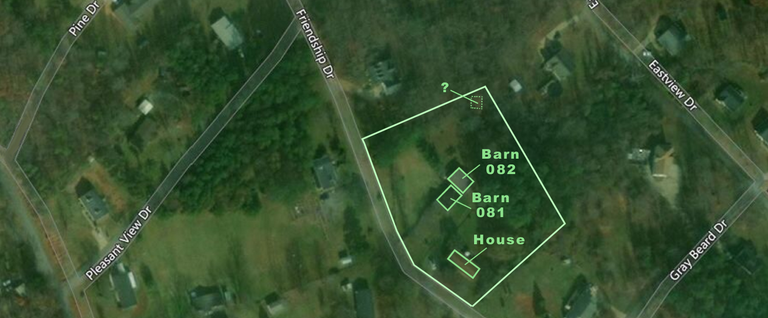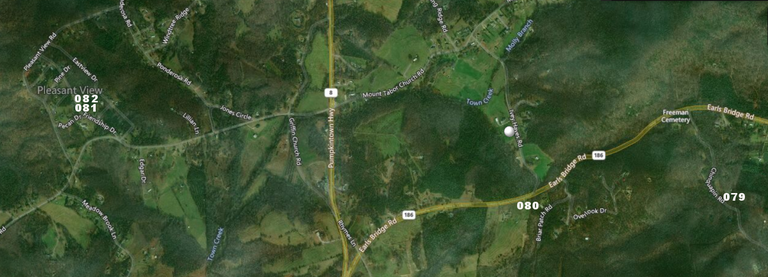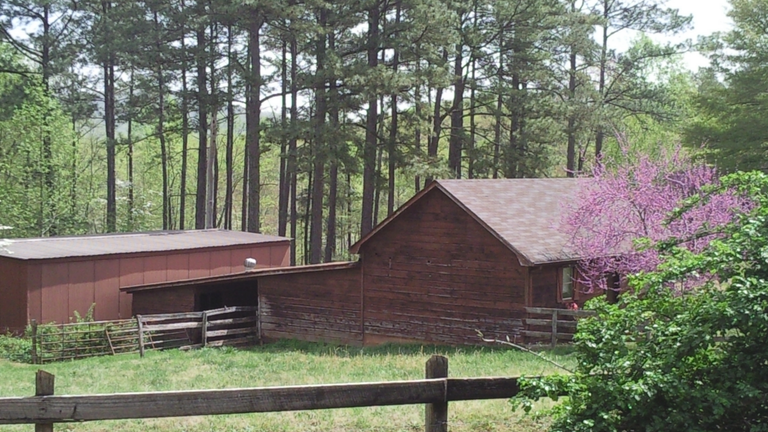OLD BARNS № 081 & 082
There is something charming in appearance about a red barn, but I can't quite put my finger on why this is so. I have often heard the reddish-colored wood on some barns called by the name "redwood" even though the wood, itself, might not be from an actual Redwood Tree. So, what is the reason for the commonly-seen red barn? I consulted the Farmer's Almanac, a reliable source of information since 1818, about this.
Hundreds of years ago, many farmers would seal their barns with linseed oil, which is an orange-colored oil derived from the seeds of the flax plant. To this oil, they would add a variety of things, most often milk and lime, but also ferrous oxide, or rust. Rust was plentiful on farms and because it killed fungi and mosses that might grow on barns, and it was very effective as a sealant. It turned the mixture red in color. When paint became more available, many people chose red paint for their barns in honor of tradition. [source]
So, now we know!
BUT...
Every time I research something like this, I find more questions that lead me into other directions, the proverbial "rabbit hole." In this case: why is the oil of the flax seed called "linseed" oil instead of "flaxseed" oil? So, I had to do some further investigation. As it turns out, the words "flax" and "linseed" are both derived from the Old English language. And from there, I tripped through articles about the flax plant, linseed (and it's processing), the Romans, the Anglo-Saxons, the evolution of European languages, and other subjects before coming back to my barn article.
As the Roman Empire crumbled and their hold over Great Britain fell apart, people from the Germanic regions of Anglia and Saxony migrated into the area. The merger of these two cultures in Britain are the Anglo-Saxons. As such, the English language has influences from the Old Germanic languages as well as Latin. [source]
The "Old English" language (sometimes called Anglo-Saxon) was the earliest recorded form of the English language. It was spoken throughout most of the island of Great Britain from the 5th through 15th centuries in the Common Era [source] and was the precursor to modern-day English.
The Old English word lin was derived from the Latin word linum, the name the Romans gave to the flax plant. [source] The Germanic people, however, used the word fleax from the proto-Germanic flakhsan [source]. So, "linum" gives rise to "linseed" while "fleax" gives rise to flax." Despite this knowledge, I still don't know why one of the words is used for the seed and the other for the plant. But, I did learn something else, however: linoleum flooring material was originally made from solidified linseed oil on a base of canvas/burlap. [source] If I ever knew that in my younger years, I had certainly forgotten it, and always thought linoleum was some plastic-like synthetic stuff, not something made from natural materials!
Anyway, enough already, on to the barns!

This lovely pairing of barns is in a semi-rural setting in Pickens County, South Carolina (US). I say "semi-rural" because the location of the barn was once quite rural, but so many other houses have been built nearby that it is more like a residential neighborhood now. Still, the owner of this barn has managed to hold onto a nice-sized piece of land for a small farm and keeps a couple of horses there. One of the barns shelters the horses in inclement weather and stores supplies that are needed for the livestock. The other barn is for equipment storage.

The following aerial view from BING Maps shows the location of these barns compared to the last couple that were featured in my blog. (Not that I expect anyone else to be interested in this, as it's more for my own documentation purposes than anything else.)

Again, for @bigtom13 and others who like seeing the original shots as well as the results of my processing, here is the starting photo of the pair of barns:

I hope you enjoyed seeings these lovely barns and reading about the way the farmers protected their barns in the old days with linseed oil! I certainly enjoyed researching it!
 😊
😊











18-Oct-2020
View or trade
BEER.Hey @thekittygirl, here is a little bit of
BEERfrom @pixresteemer for you. Enjoy it!Learn how to earn FREE BEER each day by staking your
BEER.In my world that would be a barn and a shed :) I don't know exactly what the standard was for the two categories. It wasn't pure size, and it wasn't pure shape, either. It's stuff I learned from my father and grandfather and I feel fairly comfortable with the two descriptions. Not that I can write them down :)
That was an interesting rabbit hole you exposed. We didn't raise flax but our Canadian relatives did. I did know that linoleum started as linseed oil, but at some point asphalt was added and it wasn't near so natural. I remember my dad putting a linoleum floor down in the old farmhouse. It was a serious project for him.
Our barns were all red. There was a specific 'Barn Red' when I was young that was about the color of these two. We got that from Sears and Roebuck catalog order, came in to town on the train. It was not particularly shiny and didn't last all that long so when I was probably a teenager we switched to a Sherwin Williams product that was 'firehouse red' and lasted a LONG time. Which is a good thing when it comes to painting barns.
So, to your pair. It's a good setting and a great picture. My best guess would be cows in the shed and hay in the barn. Just a guess mind you, and based on an idea from 3000 miles away and the use of our barns (and sheds :))
It's a great photo and rendition. Thank you.
That's interesting. I always thought it was more size than anything. That being said, though, I have categorized many 'outbuildings' in my Old Barn Project which I'm pretty sure were chicken coops, sheds, and other such things. I like saving them for posterity, especially the ones I have passed frequently. The actual barns are definitely more in-number, though. If you ever think of a way to put the distinctions into words, I'd love to hear them! 🙂
Hmmmmm. A Barn always had a high roof with room for loose hay in the center. There were a few round barns in the area and they fit that part of the description. Size was always part of the equation but there were some large (combine) sheds that had as much square footage as the ordinary barn.
My Grandfather had the barn built (by a regionally famous builder) on the place where I grew up. Our nearest neighbor had a barn built by the same guy at the same time. Theirs was slightly smaller and was painted grey in all my years to our red. But if one neighbor painted their barn you could be the other would the next year :)
Smaller sheds often had other names: Coop, grainery, loafing shed, milking shed etc. So I'd guess shape was/is the primary consideration. Know that may have changed, it's been over 40 years since I was really conversant. For instance we would never (and I still don't) call a pickup a truck. A truck was purpose built to haul farm goods.
Very interesting documented facts found on the history of the red paint. We use linseed oil for doors and window frames here to preserve them from wet/dry rot.
Linoleum I also learned something new always thought there was some form of plastic in the manufacture, we live and learn something new every day.
Thanks for most interesting read @thekittygirl and your ongoing series of barns in your region, so picturesque on their dwellings.
How interesting, that you do the same in South Africa! Thanks for letting us know! 😀
Well it was nice to find this at the top of my feed as I always enjoy seeing your barn posts. I am like @bigtom13 in wanting to see the original photos too, the enhanced are nice but there is something about seeing the original. Thanks for lesson on the color and linseed oil. Never knew that history but now I know.
Take care,
Sult
I thought you did. Sometimes, I am embarrassed to post the originals, as many of them are just crappy, cellphone shots, but hey... 😜
Nothing to be embarrassed about... it is just an old barn. :)
This post has received a 100.00% upvote from @fambalam! Join thealliance community to get whitelisted for delegation to this community service.
I liked all the info on the post about the linseed oil. I use it on all the tool handles to help keep them viable for another year. I quick wipe down twice a year, stat of using and at time to store it. Nice picture and edit of the barn.
Haha! Love it. Love it because I am no longer alone it looking up what some would call worthless knowledge. I like to call it historical preservation! I use boiled linseed oil with my oil paints to get a better flow. I used the boiled version because it allows for faster drying.
The barn is cool. I think the red color makes all the rustic details pop. Also I see a Eastern Redbud popping in the foreground. A sure sign of spring. 😁
You saw something no one else did! 😉 Indeed, that is an Eastern Redbud, as this photo was made in early April a few years ago, when the Redbuds were in bloom! Good eye! 😃
I have followed 'rabbit holes' ever since I was a child! 😁
Hahaha.. I am always looking beyond the subject.. after looking at the subject of course. Got to love the Rabbit Holes.. Say Hello to Alice when you run into her! hehe.
Number 81 and 82 like wow
Congratulations, your post has been added to Pinmapple! 🎉🥳🍍
Did you know you have your own profile map?
And every post has their own map too!
Want to have your post on the map too?